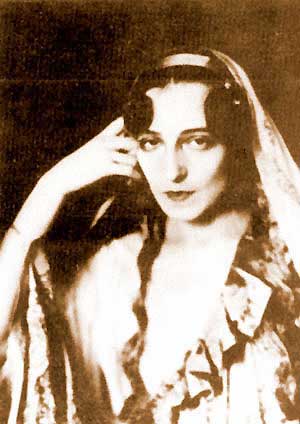|
|
Catholicism,
Casablanca, London, and the Riviera
1934-1960 |
|

Portrait of Ida (Artist & Date Unknown)
Jpeg
by M. Evans from scan of P.D. image
|

Ida Rubinstein approaching
her 50th birthday
Jpeg
by M. Evans from scan of P.D. image
|
Ida Rubinstein's
Final Commissions and Performances
Les Choephores -- From the drama by Aeschylus, translated
by Paul Claudel, Music by Darius Milhaud (1935)
Jeanne d'Arc du būcher -- An oratorio: Liberetto by Paul
Claudel, Music by Honegger (1938)
Performances:
Les Choephores -- playing Clytemnestra at the Monaie
Theater in Brussels, March 27, 1935
Persephone -- A radio broadcast from London on the BBC
for an all-Stravinsky concert November 28, 1935
Premiere of Jeanne d'Arc du būcher in Basle, Switzerland
(1938);
Two private performances of Le Martyre de Saint Sebastien
in the summer of 1938, after the death of Gabrielle D'Annunzio
on March 1st.
Rubinstein also appears in small French villages reading from
an essay entitled The Art with Three Faces, and performing
scenes from St. Sebastien.
French premiere of Jeanne d'Arc du būcher in Orleans
(1939);
Jeanne d'Arc du būcher in Paris at Palais de Challot theater
(1939);
September 3, 1939 -- World War Two begins.
Ida Rubinstein performs Jeanne d'Arc du būcher in a live
broadcast on Radio Paris, February 22, 1940.
Ida Rubenstein performs Jeanne d'Arc du būcher in Liege,
Antwerp, and Brussels in spring of 1940.
These are her last documented performances. Michael
de Cossart & Vicki Woolf
Rubinstein commissions produced after
WWII without Ida's involvement:
La Sagesse, Liberetto
by Paul Claudel, Music
by Darius
Milhaud (Radio broadcast, 1946)
Tobias and Sarah, Liberetto
by Paul Claudel, Music
by Darius
Milhaud.
(1947)
Lucifer and the Mystery of Cain, Liberetto
by Rene Dumesnil, Music by Claude Delvincourt
(1949)
Produced
under the direction of Ballet Russes veteran Serge Lifar.
Le Chevalier errant -- Liberetto
by Elizabeth de Gramont, Music by Jacques Ibert;
(1950)
Le Martyre de Saint Sebastien -- Revivals
performed in France and Italy 1949, 1950, and 1951.
Produced at the Paris Opera
House in 1957 by Serge Lifar.
Michael de Cossart
|
Biographical
Chronology:
1934-1941:
Ida Rubinstein
is made a Chevalier of the Legion of Honor in 1934, followed
by full French citizenship in February 1935. She converts to Catholicism
in 1936 and joins a lay order of Dominican sisters dedicated
to charitable works. Her Francophile upbringing, long residence in the
French capitol, and intense friendships with the outspoken Catholic
poet Paul Claudel, and mystical Gabrielle
D'Annunzio all may have contributed to her choice in this
matter. She is awarded the Grand Cross as an officer of the Legion of
Honor in 1939.
1941-1950: As France falls to invading German troops, Ida
Rubinstein flees to Algeria -- then Casablanca, Lisbon and London. Thanks
to her paramour Walter Guinness (Lord Moyne), she lives at the Ritz
Hotel in Picadilly and spends WWII caring for Free French troops in
East Grinstead and Camberley England, plus helping wounded veterans
afterwards. Her house at 7 Place des Etats-Unis in Paris is ransacked
by Nazi occupation forces, and her collections of books and art are
stolen. After the war, she completely retires from public life and temporarily
relocates to Biarritz.
1950-1960; Ida Rubinstein moves into her
last home, Les Olivades in Vence, near the city of Nice on the
French Riviera. She retreats for one month a year to the abbey of Hautecombe,
near Chambrey, France -- characteristically clad in robes made of the
finest white silk. She dies of heart failure, aged seventy-five, at
Les Olivades. Her lonely grave continues to be decorated by French
veterans, remembering the service she gave to her adopted country for
many years. Vicki
Woolf &
Michael de Cossart
|

